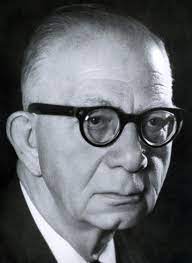A poet and a politician, Ahmet Kutsi Tecer contributed greatly to the creation of Turkish culture through his efforts in state TV channel TRT. Most of all, he introduced the legendary bard Aşık Veysel to Turkish cultural life
Ahmet Kutsi was born in 1901 in Jerusalem where his father was the Director of Public Debts. His family was from Eğin originally; namely from the Kemaliye district of Erzincan. While his first name was Ahmet, he was later given the name Kutsi (Holy) because he was born in Jerusalem.
As a child, Ahmet Kutsi resumed his education, which he had suspended in Jerusalem due to his father’s civil service, in Kırklareli. When his family eventually came to Istanbul, he graduated from Kadıköy High School and began at Halkalı Agricultural School. After completing two years of education at this school, he passed the exam for the Higher Teacher Education School and began studying in the Philosophy Department of Darülfünun (today Istanbul University).
His two years in Darülfünun would be the turning point of Ahmet Kutsi’s life. While he was studying, he became involved with Dergâh magazine where his first poems would later be published, which was then managed by Yahya Kemal and Ahmet Haşim. Even though he wrote these poems using syllabic meter, the influence of Yahya Kemal was quite prevalent.
He was sent to France on a scholarship for a medical education in 1925. While following philosophy classes in Sorbonne University, he started exploring the “seeds” of folklore, and after reading Algerian folk poets’ writings in the France National Library, Ahmet Kutsi got his first inspiration for Turkish folkloric literature.
After returning to Turkey in 1928, he graduated from Darülfunun the next year. Meanwhile, his articles began being published in Halk Bilgisi (Public Knowledge) magazine. The young poet started his folkloric studies, which held a significant influence in the cultural politics of the young Turkish Republic from the very beginning.
After graduating, Ahmet Kutsi Tecer was appointed to teach in Sivas High School, and he also continued his studies of folklore and arranged a Folk Poets Fest/Festival in 1931 in Sivas.
Managing Cultural Revolution
Although the 1930s were lifeless for most Turkish poets, Tecer became a shining star. His role in shaping the regime’s new cultural policy most likely contributed to his success. When institutions responsible for educating and spreading Kemalism (Halkevleri) opened, Tecer began managing Sivas Halkevi and became the head of education in Sivas.
While 1930s populism mixed with nationalism was an abstract ideology preached apart from and down to the populous for most bureaucrats, Tecer was sincere and humble in his spreading of populism, while he lived as a poet among the people. At the end of the 1930s, Tecer had a discussion with Ahmet Hamdi Tanpınar about the possibility of writing a modern epic poem. As a European-central modernist, Tanpınar stressed the impossibility of this type of poem, yet Tecer decided that a modern epic story could emerge from Anatolia. Tanpınar had visited Anatolia, but Tecer had actually lived there. Their opinions differed because their experiences were different. Unfortunately, while Tanpınar headed off to write novels, Tecer’s poetry was pushed aside for his folkloric studies and civil service. Thus, he had no role in writing a modern epic, which he believed in completely. In the end, the discussion between Tanpınar and Tecer concerning the modern epic was never completed.
Inventing the folklore
Having lived as a teacher and bureaucrat, Ahmet Kutsi Tecer took part in the establishment of the State Conservatory and appointed friend Muzaffer Sarısözen as the Chief of Folklore Archives. This was a critical step in structuring the future of the folk music repertoire within the state organization. The State Conservatory would become TRT Radio and later TRT Television; thus, he created the basis for the richness of today’s Turkish folk music.
He became an Adana representative during the sixth period of the Grand National Assembly of Turkey and an Urfa representative in the seventh period. In his career as a representative, culture always played a more prominent role than politics. For a while, Tecer managed “Ülkü,” the media branch of Halkevleri. Through Ülkü, Tecer was able to introduce various poets, such as Aşık Veysel and Ali İzzet, to Turkish citizens.
Ahmet Kutsi was sent abroad as a cultural attaché after his service in Parliament. And in the first years of the Democrat Party, he was the Turkish delegate to the UNESCO Executive Committee. Tecer played an undeniably significant role in UNESCO’s early knowledge of Turkish folk culture.In the 1950s, even though his political circle became the opposition in Turkey, Ahmet Kutsi went on to play important roles in several cultural institutions. He took part in the founding and management of many institutions, including the Folkloric Research Institution and in running the Turkish Linguistic Society.
Ahmet Kutsi Tecer, who fulfilled various duties in political and cultural organizations for decades, never quit teaching. He gave lessons on history, folklore and literature in the new cultural institutions of the young Republic, such as the Istanbul Municipal Conservatory, the State Conservatory, Galatasaray High School, Istanbul Radio and the Journalism Institute. In 1966, he retired from the Istanbul Institute of Education.
Ahmet Kutsi Tecer died on July 23, 1967. His tomb lies in Zincirlikuyu Cemetery.
Tecer as poet
Tecer’s poetry is not significant when compared to the great poets of his time, such as Necip Fazıl, Ahmet Hamdi and Nazım Hikmet. He was not a prolific writer; however, two of his poems have been widely celebrated: “Orda Bir Köy Var Uzakta” (Far-Away Is A Village There), which was written about his father’s village Apçağa of Kemaliye in Erzincan, and “Nerdesin” (Where Art Thou) in which the mystery and complexity of fear and hopeless love are presented in a simple way.
Ahmet Kutsi Tecer was not a great poet, but he holds an important place among the first poets of the Republic who wrote using syllabic meter. Even though he wrote using syllabic meter, following the style of Mehmet Emin and Rıza Tevfik, he is closer to Yahya Kemal in terms of tone; thus, he should be regarded relative to Ahmet Hamdi and Necip Fazıl who followed Yusuf Ziya, Orhan Seyfi and Faruk Nafiz. While these three poets, Yusuf Ziya, Orhan Seyfi and Faruk Nafiz sustained the Mehmet Emin-Mehmet Akif poetic approach, Ahmet Kutsi and his fellows were students of Yahya Kemal.

